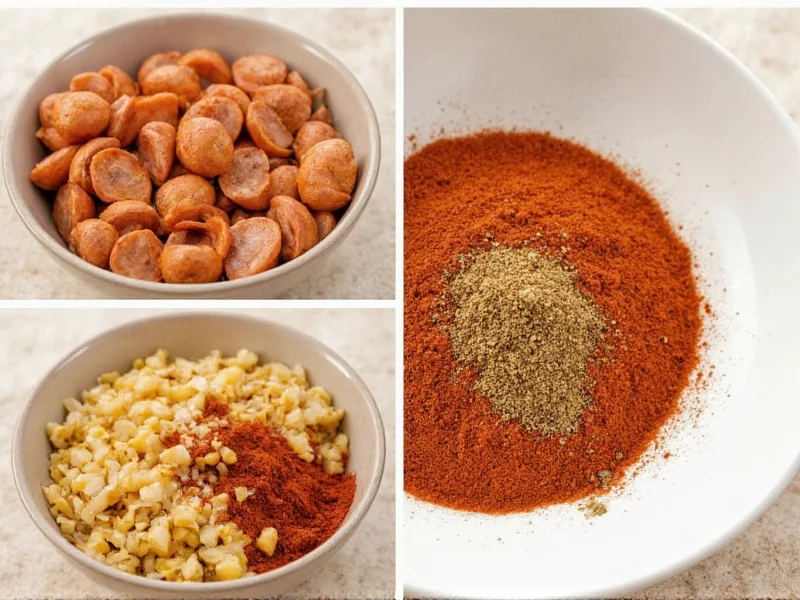Creating your own taco seasoning blend at home offers superior flavor control compared to store-bought versions. This simple spice mix eliminates unnecessary additives while allowing customization for heat level, salt content, and dietary preferences. The basic formula balances earthy, smoky, and slightly spicy notes that define authentic Mexican-inspired seasoning.
Essential Homemade Taco Seasoning Recipe
This foundational recipe yields approximately 1/4 cup of seasoning—enough for 4-5 pounds of meat. All measurements are for standard U.S. teaspoons and tablespoons.
| Spice | Amount | Flavor Contribution |
|---|---|---|
| Chili powder | 2 tablespoons | Earthy base with mild heat |
| Ground cumin | 1 tablespoon | Warm, nutty backbone flavor |
| Paprika | 1 teaspoon | Smoky depth without heat |
| Garlic powder | 1 teaspoon | Savory umami note |
| Onion powder | 1 teaspoon | Sweet aromatic foundation |
| Dried oregano | 1/2 teaspoon | Herbal complexity |
| Crushed red pepper | 1/2 teaspoon | Adjustable heat level |
| Salt | 1 teaspoon | Flavor enhancer |
Step-by-Step Preparation Guide
Follow these straightforward steps to create professional-quality taco seasoning:
- Gather all spices in their ground form for consistent texture
- Measure each ingredient precisely using proper measuring spoons
- Combine spices in a small mixing bowl
- Whisk thoroughly for 30 seconds to ensure even distribution
- Transfer to an airtight glass container away from light and heat
- Label with date and contents for future reference
Ingredient Functionality Explained
Understanding each component's role helps with successful customization:
Chili powder forms the flavor foundation—choose ancho chili powder for deeper flavor or standard blend for convenience. Cumin provides the distinctive earthy note essential to authentic Mexican seasoning. Paprika adds color and subtle smokiness without overwhelming heat.
Garlic and onion powders deliver consistent savory notes that fresh versions can't maintain in dry blends. Oregano should be Mexican oregano if available, which has a more citrusy profile than Mediterranean varieties. Red pepper flakes offer adjustable heat—reduce to 1/4 teaspoon for mild seasoning or increase to 1 teaspoon for extra spice.
Customization Options for Specific Preferences
Tailor your homemade taco seasoning to match dietary needs and taste preferences:
- Low-sodium version: Omit salt and add 1/2 teaspoon celery seed for natural saltiness
- Smoky variation: Replace paprika with smoked paprika and add 1/4 teaspoon chipotle powder
- Sweet-spicy blend: Include 1/4 teaspoon cinnamon for complex depth
- MSG-free alternative: Add 1/2 teaspoon nutritional yeast for umami richness
- Extra heat option: Incorporate 1/4 teaspoon cayenne pepper along with red pepper flakes
Storage and Usage Guidelines
Proper storage maintains flavor potency for optimal results. Keep your homemade taco seasoning in an airtight container away from direct light and heat sources. Glass jars with tight-sealing lids work best for preserving freshness.
Well-stored taco seasoning retains peak flavor for 3-4 months. After this period, the spices gradually lose potency but remain safe to use. For extended shelf life, store in the refrigerator (6 months) or freezer (1 year). Always use a dry spoon when measuring to prevent moisture contamination.
When cooking, use 2-3 tablespoons of seasoning per pound of ground meat. For best flavor integration, add the seasoning during the last 5 minutes of cooking rather than at the beginning. This technique preserves volatile flavor compounds that can dissipate with prolonged heat exposure.
Homemade vs. Commercial Taco Seasoning
Understanding the differences helps make informed choices. Commercial blends often contain anti-caking agents like silicon dioxide, fillers such as maltodextrin, and higher sodium levels (typically 300-500mg per serving). Homemade versions give complete ingredient control without unnecessary additives.
The flavor profile of homemade seasoning is noticeably brighter and more complex. Commercial versions sometimes use lower-quality spice blends that create a one-dimensional taste. By making your own taco seasoning from scratch, you control the freshness and quality of each component, resulting in superior depth of flavor.
Troubleshooting Common Issues
Address these frequent challenges when preparing homemade taco seasoning:
- Bitter flavor: Indicates old or improperly stored spices—refresh your spice collection
- Weak flavor: Spices may have lost potency—use fresher ingredients or increase measurements slightly
- Clumping: Moisture exposure—ensure all utensils are completely dry during preparation
- Overpowering heat: Reduce red pepper flakes next time and balance with additional cumin











 浙公网安备
33010002000092号
浙公网安备
33010002000092号 浙B2-20120091-4
浙B2-20120091-4